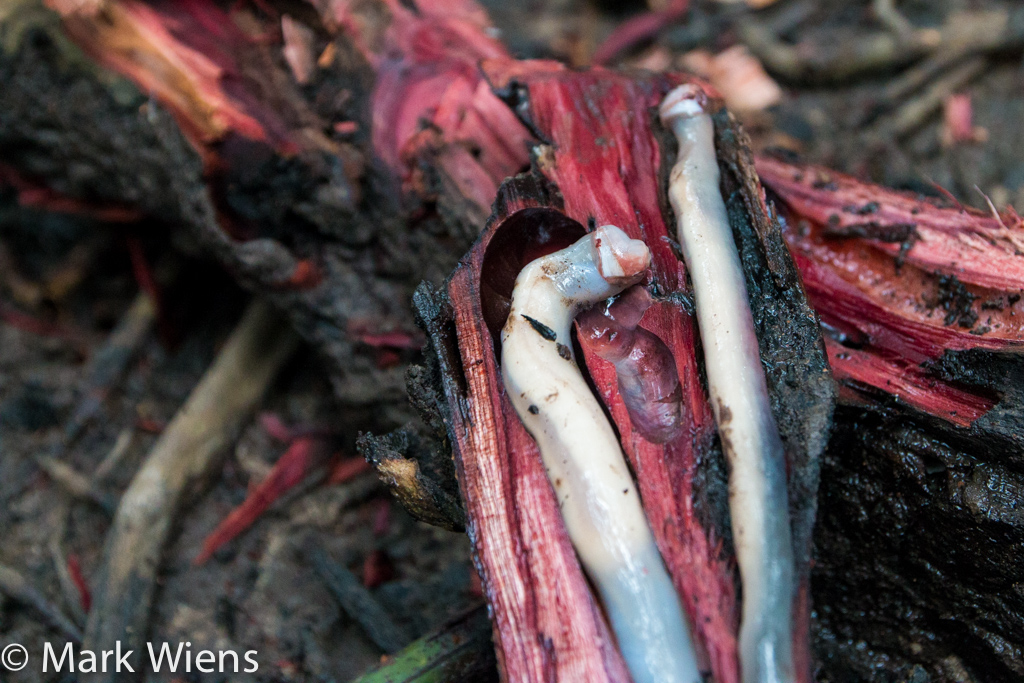

I’ve been exploring some of Thailand’s most exotic dishes, so along with eating raw pig’s blood soup in Chiang Rai, and tadpoles in Isaan, we headed to Trat Province to source and eat something known as shipworms or priyang talay (เพรียงทะเล) in Thai.
Right after we finished harvesting some lamp shell fish from the Gulf of Thailand, we then headed into the mangrove forest, on a hunt for these wood eating worms.
It’s a region of Thailand that’s known for its seafood and for its somewhat preserved tradition of fishing and use of the ocean.

What are teredo navalis (เพรียงทะเล)?
Also known as naval shipworms, teredo navalis are a type of saltwater dwelling mollusk that survive off eating wood. The head of the worms is like a drill bit, and they are able to eat their way through wood that’s usually either submerged in water or next to water.
That’s the reason they are frequently referred to as shipworms, because you can imagine they sometimes cause havoc to wooden boats. They are sort of like ocean dwelling termites.
Despite the way they look like slimy worms, they are actually much more similar to shellfish, like clams or oysters, rather than worms like grubs or inch worms.
In Thailand’s Trat province, and in other parts of southeast Asia, naval shipworms are a prized food.

A local fishermen took us to a spot in the mangrove forest, where we could dock on the roots and walk on marshy land, to find trees and pieces of wood that were potential homes to shipworms.

Our fishermen knew exactly where to search for teredo navalis (เพรียงทะเล), and in literally just a few minutes, he had found a piece of dead driftwood, and by seeing a hole in the wood, he could tell there was a shipworm dwelling inside.
Using an axe, he hacked open the log, and within the red colored soggy wood inside, sure enough, there were a pair of juicy shipworms.
Get exclusive updates
Enter your email and I’ll send you the best travel food content.

The thing you have to be careful about when harvesting shipworms is that you don’t cut them in half when you’re slicing the wood.
Not that it would really matter, but just to keep things neat it was best to slice the wood lengthwise and sort of wiggle the worms out of their wooden tunnels.

Can you see the heads of the teredo navalis?
They had a little shell, similar to any shell fish, at the front – that’s the part I call the drill bit. Shipworms go head first into a piece of wood, eating their way into a tunnel.

The head only has a tiny shell, while the body is all completely naked, slimy and soft, like the insides of an oyster, only long and skinny like a worm.

Eating them raw
Many locals in Trat eat teredo navalis (เพรียงทะเล) raw, right out of the wood. Our fisherman guide took a long one, and slurped it down like a noodle.
As tempting as it looked, I decided not to risk any water borne diseases, so I decided not to try it raw, although I really would have loved to. There’s nothing better than eating food right out of its habitat.

Gaeng liang priyang (แกงเลียงเพรียง)
While many locals eat shipworms raw, I decided to not risk the consequences of raw seafood, and so an aunty from Moo Baan Bred Nai (หมู่บ้านเปร็ดใน) village (the village where we had gone fishing, kind of an eco village in Trat) cooked a dish known as gaeng liang priyang (แกงเลียงเพรียง), basically a local teredo navalis curry.
The first step was to just take the shipworms and slice them into bite sized pieces.

The other main ingredient in the gaeng liang priyang (แกงเลียงเพรียง) was hua pli, or banana flower.
She only used the very interior of the banana flower, explaining that she only wanted the tender shoots.

The recipe was actually quite simple.
She just boiled some water, added in local shrimp paste for saltiness and flavoring, boiled down the banana flower with some Thai chilies, and then lastly added the chopped ship worms at the final stage so as to not overcook them.

As soon as she added the shipworms, the curry took on a murky color, despite there being no coconut milk in the dish.
It almost looked like tom kha gai, Thai coconut milk soup, but again, there was no coconut milk in the recipe; The creaminess was all a result of the naval shipworms.
While we were cooking, some of the ladies explained to us that priyang (เพรียงทะเล) are popular for women in Trat to eat after giving birth.

At last, the gaeng liang priyang (แกงเลียงเพรียง) was ready to be eaten, and I was ready and excited to give it a try for the first time.
How did they taste?
In all honesty, the naval shipworms had a near identical flavor to clams, and after being cooked, they had a very similar texture to any cooked shellfish.
Perhaps the pieces of shipworm were a little more earthy tasting than clams, but really it tasted quite similar. The slices of young banana flower were soft and slightly crisp in the fresh sort of way, and the broth was thin, yet slightly milky from the shipworm juices.
I can honestly say it was delicious, and if you get a chance to try gaeng liang priyang (แกงเลียงเพรียง), you shouldn’t hesitate.

Conclusion
There’s a local delicacy in the Trat province of Thailand known as priyang (เพรียง), which in English is known as either naval shipworms or teredo navalis.
Though they look like long slimy worms, in reality they’re actually sea mollusks, more similar to shellfish than worms.
When I was in Trat, along with some local fishermen, we went into the mangrove forest, and it didn’t take long before our guide had hacked open a few pieces of drift wood and was soon pulling the slimy creatures out of their wooden holes.
We took the teredo navalis (เพรียง) back to the village where a few aunties made gaeng liang priyang (แกงเลียงเพรียง), a type of curry or soup made with the teredo navalis.
It was delicious, almost like clam chowder.
Would you like to eat some priyang (เพรียง)? And would you try them raw, right out of the piece of wood?
Get exclusive updates
Enter your email and I'll send you the best travel food content.



